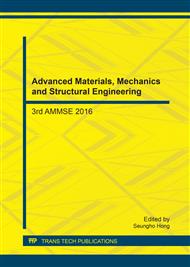[1]
J. G. Leishman. Challenges in modeling the unsteady aerodynamics of wind turbines. Wind Energ. 5 (2000) 85-132.
DOI: 10.1002/we.62
Google Scholar
[2]
J. L. Tangler, The nebulous art of using wind-tunnel airfoil data for predicting rotor performance. 21st ASME Wind Energy 2002, 190-196.
DOI: 10.2514/6.2002-40
Google Scholar
[3]
H. Himmelskamp, Profile investigations on a rotating airscrew. PhD thesis, University of Göttingen. (1945).
Google Scholar
[4]
T. Burton, D. Sharpe, N. Jenkins, E. Bossanyi, Wind energy handbook. John Wiley & Sons, (2001).
Google Scholar
[5]
D. H. Wood, A three-dimensional analysis of stall-delay on a horizontal-axis wind turbine. J. Wind Eng. Ind. Aerodyn. 1 (1991) 1-14.
DOI: 10.1016/0167-6105(91)90002-e
Google Scholar
[6]
M. Germano, U. Piomelli, P. Moin, W. Cabot, A dynamic subgrid-scale eddy viscosity model. Phys. Fluid. A: Fluid Dyn. 7 (1991) 1760-1765.
DOI: 10.1063/1.857955
Google Scholar
[7]
K. Squires, U. Piomelli, Dynamic modeling of rotating turbulence. Turbulent Shear Flows 9 (1995) 71-83.
DOI: 10.1007/978-3-642-78823-9_6
Google Scholar
[8]
I. Herráez, B. Stoevesandt, J. Peinke, Insight into rotational effects on a wind turbine blade using Navier–Stokes computations. Energ. 10 (1991) 6798-6822.
DOI: 10.3390/en7106798
Google Scholar
[9]
G. Yu, X. Shen, X. Zhu, Z. Du, An insight into the separate flow and stall delay for HAWT. Renew. Energ. 1 (2011) 69-76.
DOI: 10.1016/j.renene.2010.05.021
Google Scholar
[10]
J. Johansen, N. Sørensen, Aerofoil characteristics from 3D CFD rotor computations. Wind Energ. 4 (2004) 283-294.
DOI: 10.1002/we.127
Google Scholar
[11]
C. Rumsey, P. Spalart, Turbulence model behavior in low Reynolds number regions of aerodynamic flowfields. AIAA J. 4 (2009) 982-993.
DOI: 10.2514/1.39947
Google Scholar
[12]
D. Hu, O. Hua, Z. Du, A study on stall-delay for horizontal axis wind turbine. Renew. Energ. 6 (2006) 821–836.
DOI: 10.1016/j.renene.2005.05.002
Google Scholar
[13]
H. M. Lee, Y. Wu, A Tomo-PIV study of the effects of freestream turbulence on stall delay of the blade of a horizontal-axis wind turbine. Wind Energ. 7 (2015) 1185-1205.
DOI: 10.1002/we.1754
Google Scholar


